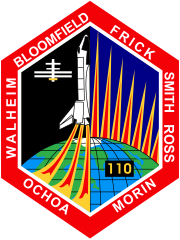STS-110

Space Shuttle Atlantis launches on STS-110, 8 April 2002
|
|
| Mission type | ISS assembly |
|---|---|
| Operator | NASA |
| COSPAR ID | 2002-018A |
| SATCAT no. | 27413 |
| Mission duration | 10 days, 19 hours, 43 minutes, 38 seconds |
| Distance travelled | 7,240,000 kilometers (4,500,000 mi) |
| Orbits completed | 171 |
| Spacecraft properties | |
| Spacecraft | Space Shuttle Atlantis |
| Launch mass | 116,609 kilograms (257,079 lb) |
| Landing mass | 91,016 kilograms (200,657 lb) |
| Payload mass | 13,132 kilograms (28,951 lb) |
| Crew | |
| Crew size | 7 |
| Members |
Michael J. Bloomfield Stephen N. Frick Rex J. Walheim Ellen L. Ochoa Lee M. E. Morin Jerry L. Ross Steven L. Smith |
| Start of mission | |
| Launch date | 8 April 2002 20:44:19 UTC |
| Launch site | Kennedy LC-39B |
| End of mission | |
| Landing date | 19 April 2002 16:26:57 UTC |
| Landing site | Kennedy SLF Runway 33 |
| Orbital parameters | |
| Reference system | Geocentric |
| Regime | Low Earth |
| Perigee | 155 kilometres (96 mi) |
| Apogee | 225 kilometres (140 mi) |
| Inclination | 51.6 degrees |
| Period | 88.3 minutes |
| Docking with ISS | |
| Docking port |
PMA-2 (Destiny forward) |
| Docking date | 10 April 2002 16:05 UTC |
| Undocking date | 17 April 2002 18:31 UTC |
| Time docked | 7 days, 2 hours, 26 minutes |
 In front, (L-R): Stephen N. Frick, Ellen L. Ochoa, Michael J. Bloomfield; In the back, (L-R): Steven L. Smith, Rex J. Walheim, Jerry L. Ross and Lee M. E. Morin. |
|
STS-110 was a Space Shuttle mission to the International Space Station (ISS) on 8–19 April 2002 flown by Space Shuttle Atlantis. The main purpose was to install the S0 Truss segment, which forms the backbone of the truss structure on the station.
The main purpose of STS-110 was to attach the S0 Truss segment to the International Space Station (ISS) to the Destiny Laboratory Module. It forms the backbone of the station to which the S1 and P1 truss segments were attached (on the following missions STS-112 and STS-113, respectively).
STS-110 also delivered the Mobile Transporter (MT), which is an 885 kilograms (1,951 lb) (1,950 lb) assembly that glides down rails on the station integrated trusses. The MT was designed and manufactured by Astro Aerospace in Carpinteria, CA. During the next shuttle mission, STS-111, the Mobile Base System (MBS) was mounted to the MT. This Mobile Servicing System (MSS) allows the Canadarm2 to travel down the length of the installed truss structure.
After a launch scrub on 4 April 2002 due to a hydrogen leak, Space Shuttle Atlantis successfully launched on 8 April 2002, from Launch Complex 39B. The countdown on 8 April encountered an unscheduled hold at the T-5 minute mark due to data dropouts in a backup Launch Processing System. The Launch Processing System team reloaded the required data and the countdown resumed. Liftoff occurred with 11 seconds remaining in the launch window.
...
Wikipedia

